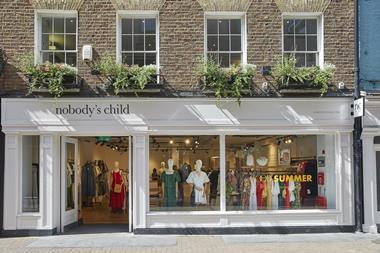Inflation has preoccupied retailers over the last few years but now fashion businesses face new questions as the prospect of deflation looms, warns Erin Brookes
Inflation was propelled to the top of retailers’ minds over the past two years as soaring prices squeezed consumers’ budgets and significantly increased operating costs.
In October 2022, the post-Covid spending boom, global supply shortages and the war in Ukraine saw inflation reach 11.1% in the UK, the highest level in four decades, with clothing and footwear inflation peaking at 8.5%.
Price hikes during this period helped alleviate some of the strain on retailers, enabling many to protect margins and maintain growth even if consumers bought less than before.
“Having already exhausted several levers to offset inflation over the past three years, some companies may find it difficult to cut operational costs further”
Now, at least for fashion retailers, this era seems to be coming to a close.
The prospect of deflation brings different questions for fashion retailers: how can earnings cope with both volumes and value under pressure? How can brands maintain integrity amid falling prices?
While the fall in fashion prices partly reflects the easing of global inflation, unusually high discounting and promotional activity has played a major role.
As the cost-of-living crisis drags on, and with consumer confidence still running low, apparel retailers have been ramping up promotions. This means that discounting is no longer confined to the traditional winter and summer Sales, and is instead becoming widespread throughout the year.
The unseasonably wet weather this spring and summer has been another factor behind fashion’s markdowns. Many retailers resorted to flash Sales. The growth of ecommerce has also intensified promotional pressure, as price-conscious shoppers can find out where a product is cheapest with a few clicks. The rise of very low-priced online players like Temu and Shein is also pushing some established players to adopt more aggressive discounting strategies.
If on the one hand deflation offers consumers some relief, on the other, it can be a tricky dynamic for apparel retailers to navigate. Falling prices mean businesses aiming to protect margins must find new ways to cover fixed costs, several of which remain elevated.
Wage growth, in particular, has been a concern this year, exacerbated by the minimum wage increase. Businesses have also been burdened by a rise in business rates.
Having already exhausted several levers to offset inflation over the past three years, some companies may find it difficult to cut operational costs further. As a result, they may have to slash spending in areas such as marketing and other central costs, and refine their product assortment to ensure productivity.
“Some players have been able to hold their nerve and resist the blanket discounting culture seen in parts of the high street”
Deflation might support retailers to boost sales volumes to sustain top-line growth. That is no small task in the current environment, with shopper sentiment still cautious. Maintaining volumes amid price drops might be even more challenging for pureplay online fashion retailers given the ongoing retrenchment of ecommerce and intensifying competition.
Regardless of channel, apparel businesses must be wary of the risk of a deflationary spiral, where consumers delay purchases in anticipation of lower prices – this trend is particularly pronounced in non-food and can cause significant pullbacks in spending.
The market is becoming increasingly competitive as brands vie for spend, so it is prudent for fashion retailers to develop a plan to withstand deflationary pressures now, while building future resilience.
With cost-saving tactics continually being refined to add balance sheet and P&L benefits, it is also critical to focus on growing sales that are less reliant on discounting. This can only happen through the optimisation of range and pricing, accurate forecasting and understanding of competitive dynamics.
Some players have been able to hold their nerve and resist the blanket discounting culture seen in parts of the high street. Marks & Spencer, for example, has called out the long-term impacts of discounting on brand value, promising to steer clear of “tricksy” pricing and keep promotions “very limited”. In the 12 months to March, 80% of the company’s sales were at full price, which chief executive Stuart Machin said helped “drive value perception”.
Finally, apparel companies should keep in mind the ebbs and flows in shopper behaviour, especially as consumers begin to benefit from lower inflation.
With their finances set to improve, fewer shoppers should feel the need to switch to cheaper products in the coming year, according to GlobalData. Instead, more are expected to trade up, a trend that is also driven by a desire for better quality, longer-lasting products.
This inflection point may offer retailers a rare opportunity to strengthen their pricing strategies and invest in brand affinity, positioning their business for sustainable growth.































No comments yet